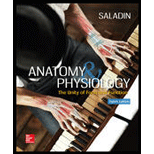
The nasal cavity is divided by the nasal septum into right and left
a. nares.
b. vestibules.
c. fossae.
d. choanae.
e. conchae.
Introduction:
The respiratory system is an organ system that is involved in respiration or breathing. The nose serves as a source of entrance for air into the respiratory tract. The nose is a protruding structure found in the face. Its essential functions are detection of odors, breathing, and amplification of the voice. The nose is made of hyaline cartilage and bone. The anterior external openings of the nose are known as nostrils.
Explanation of Solution
Correct answer:
The nasal cavity is separated by the septum into right and left fossae. Therefore, option c is correct.
Justify reasons for the correct statement:
The internal chamber of the nose is known as nasal cavity which is divided into two halves, the left and the right nasal fossae.
Option (c) is given as, “fossae”.
Nasal fossae are a cavity inside the nostril that is separated by a vertical plate known as a nasal septum which is made of bone and hyaline cartilage.
Hence, option (c) is correct.
Justify reasons for the incorrect statements:
Option (a) is given as, “nares”.
Nares or nostrils are the external openings found on the anterior part of the nose. Hence, it is a wrong answer.
Option (b) is given as, “vestibules”.
The nasal vestibules lie anterior to the nasal cavity. It is a space inside the nares. So, it is a wrong answer.
Option (d) is given as, “choanae”.
The nasal choanae is a bony aperture that is formed by the bones superiorly by sphenoid, inferiorly by palatine, posteriorly by vomer, and medially by pterygoid plate of sphenoid. Hence, it is a wrong answer.
Option (e) is given as, “conchae”.
The nasal conchae are also called as turbinate. It is a narrow, elongated sea shell shaped bone that divides the nasal airway into four groove-like air passages. Therefore, it is a wrong answer.
Hence, options (a), (b), (d), and (e) are incorrect.
The nasal septum in the nostrils divides into the left and right nasal fossae.
Want to see more full solutions like this?
Chapter 22 Solutions
Anatomy & Physiology: The Unity of Form and Function
Additional Science Textbook Solutions
Biological Science
Human Anatomy & Physiology (2nd Edition)
Genetics: From Genes to Genomes, 5th edition
Laboratory Manual For Human Anatomy & Physiology
Marine Biology (Botany, Zoology, Ecology and Evolution)
Human Biology: Concepts and Current Issues
- The exchange of gases that occurs between the alveolar sac and the pulmonary capillary a. forced inhalation b. internal respiration c. eternal respiration d. forced exhalationarrow_forwardWhich of the following is an abnormal lower airway sound associated with breathing? A) Gurgling B) Snoring C) Stridor D) Wheezingarrow_forwardThe functions of C-shaped tracheal cartilages are to prevent collapse or over-expansion of the airway and to allow expansion of the _____ a. larynx b. esophagus c. vocal cords d. stomacharrow_forward
- The lungs do not normally collapse because a. they are attached to the thoracic wall with parietal ligaments. b. they are attached to the thoracic wall with the visceral ligaments. c. the pressure in the intrapleural cavity is lower than the pressure in the intrapulmonary space (lungs). d. the pressure in the intrapleural cavity is greater than the pressure in the intrapulmonary space (lungs).arrow_forwardImmediately after the creation of an opening through the thorax intothe pleural cavitya. air flows through the hole and into the pleural cavity.b. air flows through the hole and out of the pleural cavity.c. air flows neither out nor in.d. the lung protrudes through the hole.arrow_forwardWhat happens to the glottis and the pitch of the sound when the vocal cords are adducted? What happens when they are abducted?arrow_forward
- Why does the leavator veli palatini elevate the velum to seal off the nasal cavities?arrow_forwardWhy are the alveolar walls so thin?arrow_forwardWhich of the following landmarks are used to size an oropharyngeal airway properly? A) Tip of the nose to the far portion of the ear B) Corner of the mouth to tip of ear lobe C) Corner of mouth to top of the ear D) Center of the jaw to edge of the eararrow_forward
- Basic Clinical Lab Competencies for Respiratory C...NursingISBN:9781285244662Author:WhitePublisher:Cengage


